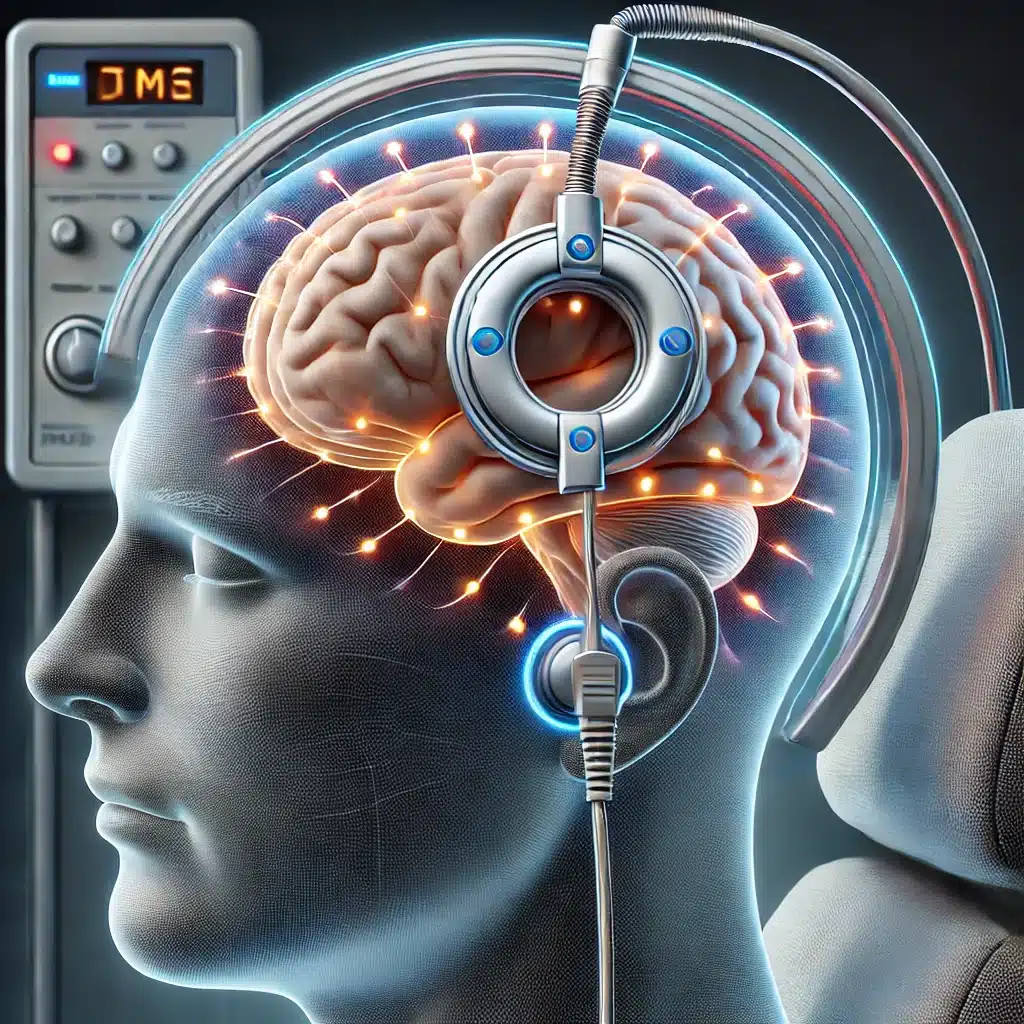Repetitive transcranial magnetic stimulation (rTMS) on the left dorsolateral prefrontal cortex (dlPFC) improves decision-making and reduces cravings in individuals with methamphetamine use disorder (MUD).
Highlights:
- Improved Decision-Making: rTMS treatment enhanced decision-making abilities in MUD patients, making their choices more rational and similar to healthy individuals.
- Craving Reduction: Participants experienced a significant decrease in cravings for methamphetamine after rTMS treatment.
- Model Parameter Changes: rTMS normalized certain decision-making model parameters, including learning rates and response consistency, which were initially abnormal in MUD patients.
- Independent Effects: Changes in decision-making abilities and reductions in cravings appear to be independent of each other, as no direct linear relationship was found.
Source: Translational Psychiatry (2024)
Major Findings: rTMS of Left DLPFC for Methamphetamine Addiction (2024)
1. Improvement in Decision-Making in Addiction
The study found that repetitive transcranial magnetic stimulation (rTMS) on the left dorsolateral prefrontal cortex (dlPFC) significantly improved decision-making abilities in individuals with methamphetamine use disorder (MUD).
Before treatment, MUD participants displayed poorer performance on the Iowa Gambling Task (IGT), a test that measures decision-making abilities.
After receiving rTMS, these participants made more advantageous choices, similar to those of healthy individuals, indicating enhanced decision-making.
2. Reduction in Meth Cravings
Participants who underwent rTMS treatment reported a substantial decrease in cravings for methamphetamine.
This finding is significant because cravings are a major factor in relapse among individuals with substance use disorders.
The decrease in cravings suggests that rTMS may help reduce the risk of relapse by alleviating this intense desire for the drug.
3. Normalization of Decision-Making Parameters
Using computational modeling, the study identified specific decision-making parameters that were abnormal in methamphetamine use disorder (MUD) participants.
These included:
- Learning Rate (A): MUD participants initially had a higher learning rate, indicating they were overly influenced by recent outcomes. Post-rTMS, their learning rate decreased to levels closer to those of healthy controls.
- Outcome Sensitivity (Alpha): MUD participants showed heightened sensitivity to outcomes, meaning they reacted strongly to both wins and losses. This sensitivity reduced following rTMS treatment.
- Response Consistency (Cons): Initially, MUD participants had low response consistency, suggesting they were more likely to make random choices. This consistency improved significantly after rTMS, leading to more predictable and rational decision-making.
- Loss Aversion (Lambda): MUD participants had lower loss aversion, meaning they were less sensitive to losses. After rTMS, their sensitivity to losses increased, aligning more closely with healthy individuals.
4. Support for the Somatic Marker Hypothesis
The results support the somatic marker hypothesis, which suggests that decision-making involves both emotional and cognitive processing.
The dlPFC plays a critical role in integrating these processes.
The study demonstrated that rTMS can modulate the function of the dlPFC, thereby improving the decision-making deficits observed in meth addiction.
This implies that rTMS might help in restoring the normal functioning of brain regions involved in decision-making.
5. Independence of Craving Reduction & Decision-Making Improvement
Interestingly, the study found no direct linear relationship between the improvements in decision-making parameters and the reduction in cravings.
This suggests that these two beneficial outcomes of rTMS treatment may occur independently of each other.
The mechanisms behind craving reduction and decision-making enhancement might be separate, indicating the need for further research to fully understand how rTMS achieves these effects.
In summary, rTMS treatment shows promise in enhancing decision-making abilities and reducing cravings in individuals with MUD, potentially offering a valuable tool for rehabilitation.
The normalization of decision-making parameters and the support for the somatic marker hypothesis further underline the therapeutic potential of targeting the dlPFC in addiction treatment.
Duration of rTMS Effects in Meth Addiction (Estimated)

The duration of the effects of repetitive transcranial magnetic stimulation (rTMS) can vary depending on the individual and the specific condition being treated.
In the context of methamphetamine use disorder (MUD), the study did not include a long-term follow-up to precisely determine how long the beneficial effects on decision-making and craving reduction last after the completion of the rTMS treatment protocol.
Generally, the effects of rTMS can last from several weeks to several months.
Maintenance sessions or additional treatment cycles may be necessary to sustain the benefits.
Cost of rTMS Treatment for Meth Use Disorder (Estimated)
The cost of rTMS treatment can vary widely depending on the country, healthcare provider, and specific protocol used.
On average, a single session of rTMS can cost between $300 to $500.
Given that the study’s protocol involved 20 sessions, the total cost for the full treatment could range from $6,000 to $10,000.
Some insurance plans may cover rTMS for certain conditions, but coverage for substance use disorders can vary and may not be universally available.
Comparison to Current Treatments for Methamphetamine Use Disorder (MUD)
Current interventions for methamphetamine use disorder typically include:
Behavioral Therapies
- Cognitive Behavioral Therapy (CBT): Helps patients recognize and avoid triggers and develop healthier coping mechanisms.
- Contingency Management (CM): Provides tangible rewards for positive behaviors like abstinence.
- Motivational Interviewing (MI): Enhances motivation to change behaviors.
Pharmacotherapy: As of now, there are no FDA-approved medications specifically for methamphetamine use disorder, although some medications are used off-label to manage symptoms or co-occurring disorders.
Support Groups & Counseling: Group therapy, individual counseling, and peer support groups like Narcotics Anonymous.
Advantages of rTMS
- Non-Invasive: Unlike some pharmacotherapies, rTMS does not require medication and is non-invasive.
- Targeted Treatment: rTMS specifically targets brain regions involved in craving and decision-making, potentially providing a more focused treatment compared to generalized behavioral therapies.
- Rapid Onset: Some patients may experience quicker relief from symptoms compared to traditional therapies that can take weeks or months to show effects.
Drawbacks of rTMS
- Cost: rTMS can be expensive, especially if not covered by insurance.
- Maintenance Required: The effects of rTMS might not be permanent, requiring follow-up or maintenance sessions.
- Availability: Access to rTMS can be limited depending on geographic location and availability of specialized equipment and trained personnel.
rTMS Protocol for Methamphetamine Addiction (Used in the Study)

The study utilized a specific repetitive transcranial magnetic stimulation (rTMS) protocol targeting the left dorsolateral prefrontal cortex (dlPFC) to assess its impact on decision-making and craving in individuals with methamphetamine use disorder (MUD).
Number of Sessions
Participants in the treatment group underwent a total of 20 rTMS sessions.
These sessions were conducted once per day over a span of 20 days, with a break of two days after every five consecutive treatment days.
This regimen was designed to balance the need for sufficient stimulation with periods of rest.
Duration & Parameters
Each rTMS session involved the following parameters:
- Frequency: The rTMS was administered at a high frequency of 10 Hz.
- Pulse Intensity: The pulse intensity was set at 100% of the resting motor threshold. The resting motor threshold was individually determined for each participant based on a 50% probability (5 out of 10 trials) of inducing a visible contraction in the index finger muscle (first dorsal interosseous, FDI).
- Pulse Duration: Each pulse lasted for 5 seconds.
- Inter-Pulse Interval: There was an interval of 10 seconds between each pulse train.
- Total Pulses per Session: Each session comprised 40 repetitions, resulting in a total of 2000 pulses per session.
Stimulation Site
The left dorsolateral prefrontal cortex (dlPFC) was targeted for stimulation.
This area was located using a positioning cap, ensuring accurate and consistent placement of the rTMS coil.
The circular coil used for the stimulation was part of the CCY-IA TMS device, provided by Wuhan Yiruide Biotechnology Co., Ltd., Wuhan, China.
Craving Measurement
Craving levels were assessed using a self-reported craving scale ranging from 1 to 100.
Participants rated their craving levels before and after the rTMS treatment period.
This measurement aimed to quantify the effect of rTMS on the intensity of cravings experienced by individuals with MUD.
Quality Control & Compliance
To ensure data integrity and participant compliance, several quality control measures were implemented.
Participants were required to complete all scales and the first Iowa Gambling Task (IGT) within one week prior to the start of the rTMS treatment.
Only participants who adhered to the protocol and completed all required tasks were included in the final analysis.
Overall, this well-structured and rigorous rTMS protocol aimed to maximize the therapeutic benefits of the treatment while ensuring participant safety and data reliability.
The study’s results provide valuable insights into the potential of rTMS as a therapeutic intervention for improving decision-making and reducing cravings in individuals with methamphetamine use disorder.
Study Overview: rTMS vs. Methamphetamine Addiction (2024)
The study aimed to explore the impact of repetitive transcranial magnetic stimulation (rTMS) on decision-making capabilities in individuals with methamphetamine use disorder (MUD).
It also sought to identify potential underlying psychological mechanisms through computational modeling techniques.
Sample
Participants: 89 male participants (18-65 years of age)
- MUD Group: 50 individuals (24 underwent rTMS treatment, 26 received no treatment).
- Healthy Controls (HC): 39 individuals.
Methods
Study Design: The study employed a pre- and post-treatment assessment.
Intervention: rTMS treatment targeted the left dorsolateral prefrontal cortex (dlPFC).
- Frequency: 10 Hz.
- Sessions: 20 sessions (one per day, with five treatments followed by two days of rest).
- Pulse Intensity: 100% of resting motor threshold.
- Total Pulses: 2000 pulses per session.
Assessment Tools:
- Iowa Gambling Task (IGT): To evaluate decision-making abilities.
- Craving Scale: Self-reported scale ranging from 1 to 100 to measure cravings.
- Computational Modeling: Used to analyze decision-making processes and parameters.
Limitations
- Sample Size: The study’s sample size was relatively small, and a larger sample size is needed to enhance the validity of the findings.
- Follow-Up: The study lacked long-term follow-up to assess the duration of the effects of rTMS.
- Self-Report Measures: The craving scale relied on self-reported data, which may be subject to bias.
- Single-Site Study: Conducted at a single site, which may limit the generalizability of the results.
- Lack of Neuroimaging: The study did not include neuroimaging to provide additional evidence of brain changes post-treatment.
- Task Testing: The IGT was not administered post-treatment to the untreated MUD group, limiting the comparison.
Conclusion: rTMS of the DL-PFC to Treat Meth Addiction
This study demonstrated that repetitive transcranial magnetic stimulation (rTMS) targeting the left dorsolateral prefrontal cortex (dlPFC) can significantly improve decision-making abilities and reduce cravings in individuals with methamphetamine use disorder (MUD).
The intervention normalized specific decision-making parameters and supported the somatic marker hypothesis by implicating the dlPFC in the decision-making deficits observed in MUD.
Despite the promising results, the study highlights the need for further research to understand the long-term effects and mechanisms of rTMS.
The findings suggest that rTMS could be a valuable addition to current treatment options for MUD, offering a non-invasive method to enhance cognitive function and reduce relapse risk.
References
- Study: Modulation of dlPFC function and decision-making capacity by repetitive transcranial magnetic stimulation in methamphetamine use disorder (2024)
- Authors: Qingming Liu et al.







